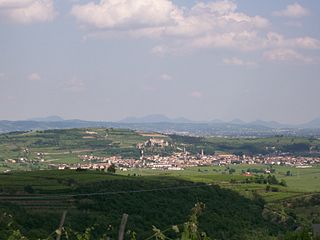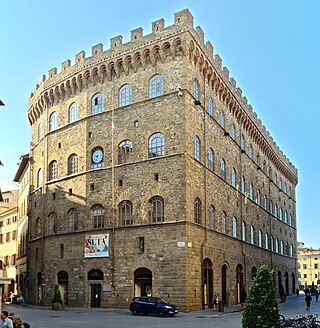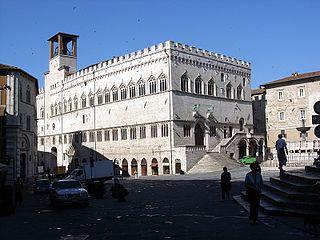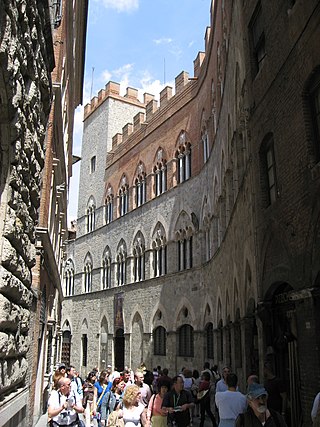
Montalcino is a hill town and comune in the province of Siena, Tuscany, central Italy.

Arezzo is a city and comune in Italy and the capital of the province of the same name located in Tuscany. Arezzo is about 80 kilometres southeast of Florence at an elevation of 296 metres (971 ft) above sea level. As of 2022, the population was about 97,000.

San Gimignano is a small walled medieval hill town in the province of Siena, Tuscany, north-central Italy. Known as the Town of Fine Towers, San Gimignano is famous for its medieval architecture, unique in the preservation of about a dozen of its tower houses, which, with its hilltop setting and encircling walls, form "an unforgettable skyline". Within the walls, the well-preserved buildings include notable examples of both Romanesque and Gothic architecture, with outstanding examples of secular buildings as well as churches. The Palazzo Comunale, the Collegiate Church and Church of Sant' Agostino contain frescos, including cycles dating from the 14th and 15th centuries. The "Historic Centre of San Gimignano" is a UNESCO World Heritage Site. The town also is known for saffron, the Golden Ham, pecorino cheese and its white wine, Vernaccia di San Gimignano, produced from the ancient variety of Vernaccia grape which is grown on the sandstone hillsides of the area.

Todi is a town and comune (municipality) of the province of Perugia in central Italy. It is perched on a tall two-crested hill overlooking the east bank of the river Tiber, commanding distant views in every direction. It was founded in antiquity by the Umbri, at the border with Etruria; the family of Roman Emperor Trajan came from Todi.

Spello is an ancient town and comune (township) of Italy, in the province of Perugia in eastern-central Umbria, on the lower southern flank of Mt. Subasio. It is 6 km (4 mi) NNW of Foligno and 10 km (6 mi) SSE of Assisi. It is one of I Borghi più belli d'Italia.

Grosseto is a comune in the central Italian region of Tuscany, the capital of the province of Grosseto. The city lies 14 kilometres from the Tyrrhenian Sea, in the Maremma, at the centre of an alluvial plain on the Ombrone river.

Iesi is a comune (municipality) in the province of Ancona, in the Italian region of Marche.

The Palazzo Pubblico is a palace in Siena, Tuscany, central Italy. Construction began in 1297 to serve as the seat of the Republic of Siena's government, which consisted of the Podestà and Council of Nine, the elected officials who performed executive functions. The palace is of medieval and Gothic architecture, and the interior is lined with frescoes--most importantly, the collection known as The Allegory of Good and Bad Government by Ambrogio Lorenzetti.

Pienza is a town and comune in the province of Siena, Tuscany, in the historical region of Val d'Orcia. Situated between the towns of Montepulciano and Montalcino, it is considered the "touchstone of Renaissance urbanism".

Piazza Armerina is a comune in the province of Enna of the autonomous island region of Sicily, southern Italy.

San Miniato is a town and comune in the province of Pisa, in the region of Tuscany, Italy.

Soave is a small comune of the Veneto region in the Province of Verona, northern Italy, with a population of roughly 6,800 people.

Palazzo Spini Ferroni is a large Gothic palace located along Via de' Tornabuoni at the corner of Piazza Santa Trinita, in central Florence, Tuscany, Italy. It stands across from the church of Santa Trinita.

The Palazzo dei Priori or comunale is one of the best examples in Italy of a public palace from the communal era. It is located in the central Piazza IV Novembre in Perugia, Umbria. It extends along Corso Vannucci up to Via Boncambi. It still houses part of the municipality, and, on the third floor, the Galleria Nazionale dell'Umbria. It takes its name from the Priori, the highest political authority governing the city in the medieval era.

Gothic architecture appeared in the prosperous independent city-states of Italy in the 12th century, at the same time as it appeared in Northern Europe. In fact, unlike in other regions of Europe, it did not replace Romanesque architecture, and Italian architects were not very influenced by it. However, each city developed its own particular variations of the style. Italian architects preferred to keep the traditional construction methods established in the previous centuries; architectural solutions and technical innovations of French Gothic were seldom used. Soaring height was less important than in Northern Europe. Brick rather than stone was the most common building material, and marble was widely used for decoration. In the 15th century, when the Gothic style dominated both Northern Europe and the Italian Peninsula, Northern Italy became the birthplace of Renaissance architecture.

The Palazzo Chigi-Saracini is a Gothic urban palace on the Via di Città in the Terzo di Città in central Siena, Tuscany, Italy. It is the seat of the Accademia Musicale Chigiana.

The Palazzo Comunale, also known as the Palazzo del Popolo of San Gimignano has been the seat of the civic authority in the comune since the 13th century. It is located on the Piazza del Duomo close to the Collegiate Church of the Assumption of the Blessed Virgin Mary. The building and Collegiate Church are at the heart of the medieval town, and are part of the UNESCO World Heritage Site of the "Historic Centre of San Gimignano".

North-Western Italian architecture refers to architecture in the North-Western regions of Italy, and their capital cities.

The Palazzo Bichi Ruspoli, or previously Palazzo or Castellare dei Rossi, is an urban palace, located on Via Banchi di Sopra in the present contrada of Civetta, Terzo di Camollia of the city of Siena, region of Tuscany, Italy.

The Palazzo Piccolomini-Clementini is a Gothic-style palace located on Via Banchi di Sotto #75 in the city of Siena, region of Tuscany, Italy. It is located across the street from the more imposing Renaissance-style Palazzo Piccolomini and the Loggia del Papa. The nearby Palazzo delle Papesse was also built by a Piccolomini family member.



















